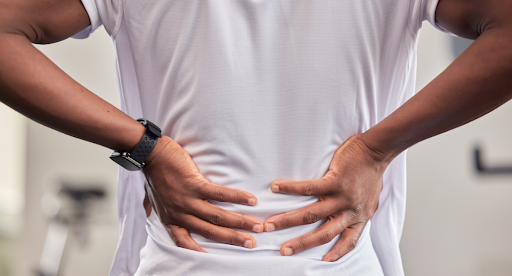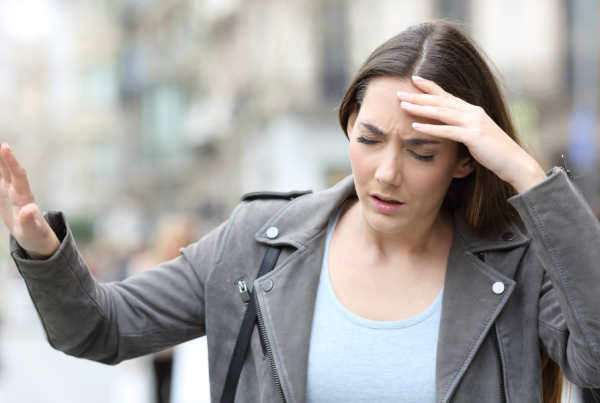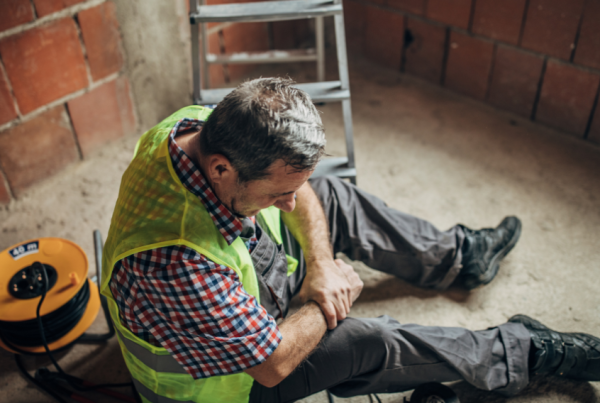Low Back Pain
Move Better. Live Fuller. Your Wellness Journey Starts Here.
Schedule a FREE Discovery Call!
What Is Low Back Pain?
Low back pain is a very common condition that a large portion of the community experiences, due to a wide variety of factors. It can vary widely in terms of intensity, duration, and cause.
Low back pain can be mild and last a short time (such as a few days), or it can be very severe and long-lasting, such as for many months or even years. The pain may also spread to other areas of the body such as the buttocks, hips and pelvis.

Because low back pain can vary so widely and is often associated with many other medical conditions, it is important to get into physical therapy straight away. This will allow your physical therapist to identify your limitations and start working on an evidence-based, comprehensive plan of care.
Some symptoms you may experience relating to low back pain include the following:
- Pain: Can feel like a dull, aching pain that is constant and may radiate to other parts of the body. Or, the pain can be more severe, felt as a sharp, stabbing pain that is often triggered by movement.
- Radiating Pain: Low back pain can be felt in other parts of the body, often in the hips, and/or one or both legs (especially with sciatica).
- Muscle Tightness: Feelings of inflexibility, difficulty moving, muscle spasms, and discomfort may be felt in the lower back, pelvis, and hips.
- Lower Range of Motion: Low back pain can make it difficult for individuals to move, walk, stand, and perform other daily activities without pain.
- Numbness and Tingling: These sensations can be felt most often with pain related to nerve compression, and are usually felt in the lower back, buttocks, legs, and feet.
- Weakness: Some individuals may have difficulty standing due to weakness in the legs or feet—another common symptom of nerve compression.
What Causes Low Back Pain?
Low back pain can be caused by many things. The natural aging process can affect the health of your spine and muscles, as well as the daily movements you perform. Repetitive movements, improper posture, sleeping positions, injury, and much more can contribute to back pain.
Pain in the lower back is referred to by many different names, often depending on the situation and symptoms. Lumbago is a general term for low back pain, but in other scenarios where a cause is suggested or symptoms are more specific, other medical terminologies are used—such as the following:
- Sciatica: A condition involving the sciatic nerve, where pain radiates along the path of the nerve due to irritation or compression.
- Chronic Low Back Pain: More severe and persistent back pain that can last more than a few months. May suggest underlying conditions.
- Acute Low Back Pain: Less severe back pain that lasts anywhere from a few days to a few weeks.
- Mechanical Low Back Pain: Back pain created by injury or complications with the spine; specifically spinal joints, vertebrae, muscles, ligaments, or tendons.
- Lumbar Spine Pain: Term referring to pain in the lower portion of the back (lumbar region).
- Lumbar Strain: Pain in the lumbar area, often caused by strain of a muscle, tendon, or ligament.
- Lumbar Radiculopathy: Low back pain that involves nerve compression, causing pain, tingling, and numbness that may radiate down into the leg(s).
- Degenerative Disc Disease: Age-related degeneration of the intervertebral discs, wearing away the cushioning of the spine and resulting in pain.
- Herniated Disc: Similar to the above condition, this is pain in the lower back caused by injury to an intervertebral disc. This can cause pressure onto a nerve which not only causes pain, but often weakness or numbness as well.
- Spondylolysis / Spondylolisthesis: Involves back pain caused by problems with the spine, particularly injury or fractures of the vertebrae. Specifically, spondylolysis is a stress fracture that can evolve into spondylolisthesis, where the vertebrae slips out of alignment due to the fracture progressing.
Physical Therapy for Low Back Pain
Physical therapy is a common treatment for low back pain that focuses on increasing strength and flexibility of the muscles in the area. A physical therapist can help restore your range of motion and significantly reduce pain in the lower back.
First, your physical therapist will discuss your symptoms with you to better understand the intensity and location of the pain, when it occurs, and for how long. They may also ask about frequent movements you perform at home or at your job to better understand possible contributions to your pain. They’ll discuss your medical history and any related conditions that could contribute to your low back pain.
They may perform observations and physical examinations of your posture, spinal alignment, range of motion, strength, and flexibility. They may check for any swelling, tenderness, or possible involvement of the nerves. These physical examinations can help rule out underlying conditions, and better allow your physical therapist to identify suitable treatments.
Low back pain is not normally an extreme condition, but in the more severe cases, seeking physical therapy can help prevent the need for surgery. Treatment can include pain-relieving techniques such as manual therapy, therapeutic modalities, and dry needling, or exercises that work to improve strength and flexibility. Your physical therapist can also help educate you on proper postures and form for daily activities in order to help prevent future complications. This may include posture for sitting, standing, walking, or other activities such as working at a desk or performing chores.
Low back pain varies by the individual, and so treatment will vary from person to person, too. At Hive Therapy and Wellness, we always cater treatment to the individual’s needs, formulating a personalized treatment just for you! Some common treatment methods you can expect when working with Hive Therapy and Wellness include:
- Dry Needling
- Cupping
- Manual Therapy
- Spinal Manipulation
- Electrical Muscle Stimulation
- Tissue Scraping
- Exercise Prescription
- Behavioral Modifications
- Therapeutic Modalities
- Neuromuscular Re-education
- Biofeedback
- Therapeutic Activity
Low back pain is a very common condition that a large portion of the community experiences, due to a wide variety of factors. It can vary widely in terms of intensity, duration, and cause.
Low back pain can be mild and last a short time (such as a few days), or it can be very severe and long-lasting, such as for many months or even years. The pain may also spread to other areas of the body such as the buttocks, hips and pelvis.
Because low back pain can vary so widely and is often associated with many other medical conditions, it is important to get into physical therapy straight away. This will allow your physical therapist to identify your limitations and start working on an evidence-based, comprehensive plan of care.
Some symptoms you may experience relating to low back pain include the following:
- Pain: Can feel like a dull, aching pain that is constant and may radiate to other parts of the body. Or, the pain can be more severe, felt as a sharp, stabbing pain that is often triggered by movement.
- Radiating Pain: Low back pain can be felt in other parts of the body, often in the hips, and/or one or both legs (especially with sciatica).
- Muscle Tightness: Feelings of inflexibility, difficulty moving, muscle spasms, and discomfort may be felt in the lower back, pelvis, and hips.
- Lower Range of Motion: Low back pain can make it difficult for individuals to move, walk, stand, and perform other daily activities without pain.
- Numbness and Tingling: These sensations can be felt most often with pain related to nerve compression, and are usually felt in the lower back, buttocks, legs, and feet.
- Weakness: Some individuals may have difficulty standing due to weakness in the legs or feet—another common symptom of nerve compression.
Low back pain can be caused by many things. The natural aging process can affect the health of your spine and muscles, as well as the daily movements you perform. Repetitive movements, improper posture, sleeping positions, injury, and much more can contribute to back pain.
Pain in the lower back is referred to by many different names, often depending on the situation and symptoms. Lumbago is a general term for low back pain, but in other scenarios where a cause is suggested or symptoms are more specific, other medical terminologies are used—such as the following:
- Sciatica: A condition involving the sciatic nerve, where pain radiates along the path of the nerve due to irritation or compression.
- Chronic Low Back Pain: More severe and persistent back pain that can last more than a few months. May suggest underlying conditions.
- Acute Low Back Pain: Less severe back pain that lasts anywhere from a few days to a few weeks.
- Mechanical Low Back Pain: Back pain created by injury or complications with the spine; specifically spinal joints, vertebrae, muscles, ligaments, or tendons.
- Lumbar Spine Pain: Term referring to pain in the lower portion of the back (lumbar region).
- Lumbar Strain: Pain in the lumbar area, often caused by strain of a muscle, tendon, or ligament.
- Lumbar Radiculopathy: Low back pain that involves nerve compression, causing pain, tingling, and numbness that may radiate down into the leg(s).
- Degenerative Disc Disease: Age-related degeneration of the intervertebral discs, wearing away the cushioning of the spine and resulting in pain.
- Herniated Disc: Similar to the above condition, this is pain in the lower back caused by injury to an intervertebral disc. This can cause pressure onto a nerve which not only causes pain, but often weakness or numbness as well.
- Spondylolysis / Spondylolisthesis: Involves back pain caused by problems with the spine, particularly injury or fractures of the vertebrae. Specifically, spondylolysis is a stress fracture that can evolve into spondylolisthesis, where the vertebrae slips out of alignment due to the fracture progressing.
Physical therapy is a common treatment for low back pain that focuses on increasing strength and flexibility of the muscles in the area. A physical therapist can help restore your range of motion and significantly reduce pain in the lower back.
First, your physical therapist will discuss your symptoms with you to better understand the intensity and location of the pain, when it occurs, and for how long. They may also ask about frequent movements you perform at home or at your job to better understand possible contributions to your pain. They’ll discuss your medical history and any related conditions that could contribute to your low back pain.
They may perform observations and physical examinations of your posture, spinal alignment, range of motion, strength, and flexibility. They may check for any swelling, tenderness, or possible involvement of the nerves. These physical examinations can help rule out underlying conditions, and better allow your physical therapist to identify suitable treatments.
Low back pain is not normally an extreme condition, but in the more severe cases, seeking physical therapy can help prevent the need for surgery. Treatment can include pain-relieving techniques such as manual therapy, therapeutic modalities, and dry needling, or exercises that work to improve strength and flexibility.
Your physical therapist can also help educate you on proper postures and form for daily activities in order to help prevent future complications. This may include posture for sitting, standing, walking, or other activities such as working at a desk or performing chores.
Low back pain varies by the individual, and so treatment will vary from person to person, too. At Hive Therapy and Wellness, we always cater treatment to the individual’s needs, formulating a personalized treatment just for you! Some common treatment methods you can expect when working with Hive Therapy and Wellness include:
- Dry Needling
- Cupping
- Manual Therapy
- Spinal Manipulation
- Electrical Muscle Stimulation
- Tissue Scraping
- Exercise Prescription
- Behavioral Modifications
- Therapeutic Modalities
- Neuromuscular Re-education
- Biofeedback
- Therapeutic Activity
You can learn more about these treatments on our Treatments Page.





